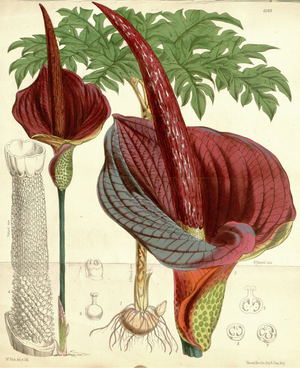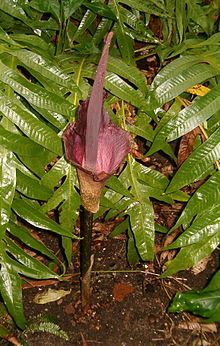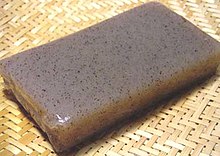Devil's tongue
| Devil's tongue | ||||||||||||
|---|---|---|---|---|---|---|---|---|---|---|---|---|

Various details of the devil's tongue ( Amorphophallus konjac ) - lithograph by Walter H. Fitch |
||||||||||||
| Systematics | ||||||||||||
|
||||||||||||
| Scientific name | ||||||||||||
| Amorphophallus konjac | ||||||||||||
| K. Koch |
The devil's tongue ( Amorphophallus konjac , Syn. : Amorphophallus rivieri ) is a plant from the genus of the titanium seasoning ( Amorphophallus ) within the family of Araceae (Araceae). In Austria it is also called the tear tree. The tuber is called konjac root .
Occurrence
The devil's tongue originally comes from Southeast Asia - according to a source from Vietnam - but today it is widespread in the whole of East Asia, from Japan and China to Indonesia . The devil's tongue prefers moist and partially shaded locations in the tropics and subtropics there.
description
The devil's tongue is a perennial herbaceous plant . This geophyte grows from a tuber , which can reach up to 25 cm in diameter. In the late spring, the konjac root forms a single leaf that is reminiscent of a tree in the shape of an umbrella and is as tall as it is wide. The information on the maximum height of this leaf fluctuates between 1.3 and 2.5 m. The leaf is double-pinnate and divided into three parts into countless leaf-like structures. After the initial growth phase, the leaf remains stable throughout the summer until the nutrients move back into the tuber in autumn. The remnants of the leaf dry out and become detached from the tuber.
The plant is single sexed ( monoecious ). Adult plants form an inflorescence in early spring . This consists of a dark purple bulb (spadix) with a length of up to 55 cm, which is enveloped by a bract ( spathe ). On the flask are the female flowers at the bottom and the male flowers at the top. As with many species of the genus Amorphophallus , the inflorescence gives off a strong carrion odor . This attracts the insects that ensure pollination.
From an ecological point of view, it is a kettle trap flower . Pollination takes place in two steps. The insects are lured into the bottom of the kettle trap flower . There they pollinate the single female flowers sitting at the bottom of the piston with the pollen brought by other individuals. The insects remain at the base of the spathe until the female flowers can no longer be pollinated. Only then do the male flowers on the top of the bulb open and pour their pollen onto the insects, which then carry the pollen to the next inflorescence. This mechanism avoids self-pollination.
The piston or spadix exudes droplets of liquid at the beginning of the flowering phase and also heats up in the process. This starts the odor-intensive phase. This behavior has given the plant the further German name "tear tree".
Orange berries are formed.
The number of chromosomes is 2n = 26.
Systematics
The first description by the German botanist Karl Heinrich Emil Koch was published in 1858. The following synonyms : Amorphophallus rivieri Durieu ex Carrière , Amorphophallus rivieri . Var konjac (K. Koch) Engl.
cultivation
The devil's tongue is a rare but not very demanding container plant. Their leaves can grow up to 2.5 m high and about 1.80 m in diameter in humus and permeable soil. In autumn the leaf collapses and the tuber can overwinter in a cool place protected from frost. From a tuber weight of around 500 g, a rather imposing flower forms in early spring, which smells just as strong as its big brother Titan Arum ( Amorphophallus titanum ). The amazing thing about it: the tuber drives the inflorescence without being potted.
The devil's tongue forms daughter tubers during the growing season , which are no longer connected to the parent tubers after the growing season has ended.
use
The tuber is rich in glucomannans ( polysaccharides ). It shows excellent film-forming properties and has a hydrating effect.
In Japan in particular , the konjac root is used in the food industry. In the EU, konjac root flour ( konjak flour ) is traded as a food additive E 425. The konjac root is often used in cosmetic products.
In Japanese cuisine konjac is - there konnyaku ( Jap. 蒟蒻 or 菎蒻 called) - in dishes like Oden used. It is typically spotted gray, has a gel-like consistency and is almost tasteless. It is a low energy density food that is valued more for its texture than for its taste.
Japanese konjak gel is made by mixing konjak flour with water and a saturated solution of calcium hydroxide . Hijiki is often added to give the mixture a different taste and a dark color. After that, the mixture is boiled and hardened. Konjak in noodle form is called " shirataki " and is used in foods such as sukiyaki and gyūdon .
Konjac is also used in the popular fruit snacks that are offered in plastic cups: jelly sweets in mini cups ("jelly mini-cups"). These snacks are widely exported from Asian countries. There were suffocation deaths in the late 1990s, leading to product recalls in the United States and Canada. Unlike gelatin , konjac does not dissolve quickly in the mouth. That is why the snacks always have warning labels that remind parents that children must chew the snacks well before swallowing them. The EU has changed its Directive 95/2 / EC to limit the amount of konjak gum and konjac glucomannan in food to 10 g / kg, published in the Official Journal of the European Communities , 2002 / C 331 E / 26. The import of jelly mini cups into the EU is prohibited.
Individual evidence
- ↑ a b c Amorphophallus konjac (Araceae). pages.unibas.ch, November 14, 2004, archived from the original on March 20, 2006 ; accessed on January 2, 2017 .
- ↑ Tropicos: Devil's Tongue
- ↑ weekly Plant nursery 1: 262. 1858. See entry in GRIN Taxonomy for Plants .
- ↑ Directive 95/2 / EG (PDF; 345 kB)
- ↑ OJ. EG 2002 / C 331 E / 26 (PDF; 83 kB)
Web links
- The Devil's Tongue in the Botanical Garden of the University of Basel ( Memento from March 20, 2006 in the Internet Archive )
- Glucomannan: Tuber with weight loss effect , test.de, accessed on November 27, 2016.
- Amorphophallus konjac from Useful Tropical Plants, accessed October 18, 2018.







